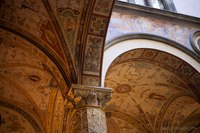Florence ⚜
Photos of Florence, Italy, including the Cathedral of Santa Maria del Fiore (Saint Mary of the Flower), Palazzo Vecchio, the Loggia dei Lanzi, and panoramic views of the city.
Dome of the Cathedral of Florence
 Inspired by the Pantheon of Rome, Filippo Brunelleschi was responsible for this 15th century dome (built between 1420 and 1436), which crowns the Cathedral of Santa Maria del Fiore and is so representative of Florence. The construction of this imposing structure was quite a challenge at the time, but also an achievement at the beginning of the Renaissance; it has an external diameter of 45 meters (148 feet), and adds up considerably to the cathedral’s height of 114 meters (374 feet). When including the cross and the bronze orb, a work by Andrea del Verrocchio, the cathedral reaches approximately 116 meters (380 feet).
Inspired by the Pantheon of Rome, Filippo Brunelleschi was responsible for this 15th century dome (built between 1420 and 1436), which crowns the Cathedral of Santa Maria del Fiore and is so representative of Florence. The construction of this imposing structure was quite a challenge at the time, but also an achievement at the beginning of the Renaissance; it has an external diameter of 45 meters (148 feet), and adds up considerably to the cathedral’s height of 114 meters (374 feet). When including the cross and the bronze orb, a work by Andrea del Verrocchio, the cathedral reaches approximately 116 meters (380 feet).
The city of Florence
 A photo of the historic quarter from Michelangelo square. On the right, the Florence cathedral, and on the center, the Palazzo Vecchio, which can be seen in more detail in other photos.
A photo of the historic quarter from Michelangelo square. On the right, the Florence cathedral, and on the center, the Palazzo Vecchio, which can be seen in more detail in other photos.
Façade of the Cathedral of Santa Maria del Fiore
 Just as Notre-Dame of Paris, the façade of Santa Maria del Fiore, which shares in part the Gothic style, includes a rose window; elaborate cornices; niches with statues of various personalities related to the history of Florence; and three portals with tympana portraying various religious scenes, such as the one on the photo representing Christ enthroned with Mary and John the Baptist.
Just as Notre-Dame of Paris, the façade of Santa Maria del Fiore, which shares in part the Gothic style, includes a rose window; elaborate cornices; niches with statues of various personalities related to the history of Florence; and three portals with tympana portraying various religious scenes, such as the one on the photo representing Christ enthroned with Mary and John the Baptist.
Giotto's Bell tower and Florence Cathedral façade by day
 The multicolored inlaid marble paneling is similar to the Pisan Romanesque style of the cathedral and baptistery of Saint John in Pisa, another architectural achievement in the Tuscany region, although the Florentine Romanesque style has its uniqueness.
The multicolored inlaid marble paneling is similar to the Pisan Romanesque style of the cathedral and baptistery of Saint John in Pisa, another architectural achievement in the Tuscany region, although the Florentine Romanesque style has its uniqueness.
The Abduction of Polyxena
 A sculpture by Pio Fedi in the Loggia dei Lanzi, an open air gallery in piazza della Signoria. On a side note, the title of this work is frequently mentioned in English as "The Rape of Polyxena," even in academic works, which is unfortunately a wrong translation of the original Italian title "Il Ratto di Polissena," where Ratto refers to abduction or kidnapping, not rape, which is known as "stupro" in Italian, and Fedi’s title for this work is definitely not "Lo stupro di Polissena." Behind the sculpture you can see the beginning of the Vasarian Corridor, a work by Giorgio Vasari, which is a communication linking Palazzo Vecchio and Palazzo Pitti, on the other side of the Arno River.
A sculpture by Pio Fedi in the Loggia dei Lanzi, an open air gallery in piazza della Signoria. On a side note, the title of this work is frequently mentioned in English as "The Rape of Polyxena," even in academic works, which is unfortunately a wrong translation of the original Italian title "Il Ratto di Polissena," where Ratto refers to abduction or kidnapping, not rape, which is known as "stupro" in Italian, and Fedi’s title for this work is definitely not "Lo stupro di Polissena." Behind the sculpture you can see the beginning of the Vasarian Corridor, a work by Giorgio Vasari, which is a communication linking Palazzo Vecchio and Palazzo Pitti, on the other side of the Arno River.
Santa Maria del Fiore from the streets of Florence
 Buildings framing the cathedral in the historical center of Florence.
Buildings framing the cathedral in the historical center of Florence.
Ponte Vecchio by day
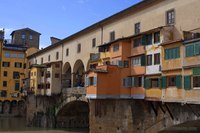 Ponte Vecchio ("Old Bridge") is a medieval bridge of 1345, although its origin is even more ancient, since it is probably the third built in the same location. The first one, built during the Roman empire, is believed to have existed already in the year 996, and was destroyed by floods, just as the second one. The third and current bridge was almost destroyed by the Nazis during the Second World War.
Ponte Vecchio ("Old Bridge") is a medieval bridge of 1345, although its origin is even more ancient, since it is probably the third built in the same location. The first one, built during the Roman empire, is believed to have existed already in the year 996, and was destroyed by floods, just as the second one. The third and current bridge was almost destroyed by the Nazis during the Second World War.
Bicycle of a store in the streets of Florence
Detail of the apse of the Florence Cathedral
 This section of the building corresponds to the area of the sacristy and apse of the cathedral, which, just as the Cathedral of Pisa and many other Christian temples is oriented towards the East, following the east-west liturgical axis. This classical orientation has exceptions such as St. Peter’s basilica in the Vatican, which has the opposite orientation, or the Barcelona Cathedral and Notre-Dame of Paris, which have a south-east orientation.
This section of the building corresponds to the area of the sacristy and apse of the cathedral, which, just as the Cathedral of Pisa and many other Christian temples is oriented towards the East, following the east-west liturgical axis. This classical orientation has exceptions such as St. Peter’s basilica in the Vatican, which has the opposite orientation, or the Barcelona Cathedral and Notre-Dame of Paris, which have a south-east orientation.
Little angel with Dolphin in the Palazzo Vecchio
Photo of the statute entitled "Putto with Dolphin" by Andrea del Verrocchio, next to which you can also see the stucco decorated columns of the Palazzo’s first courtyard.
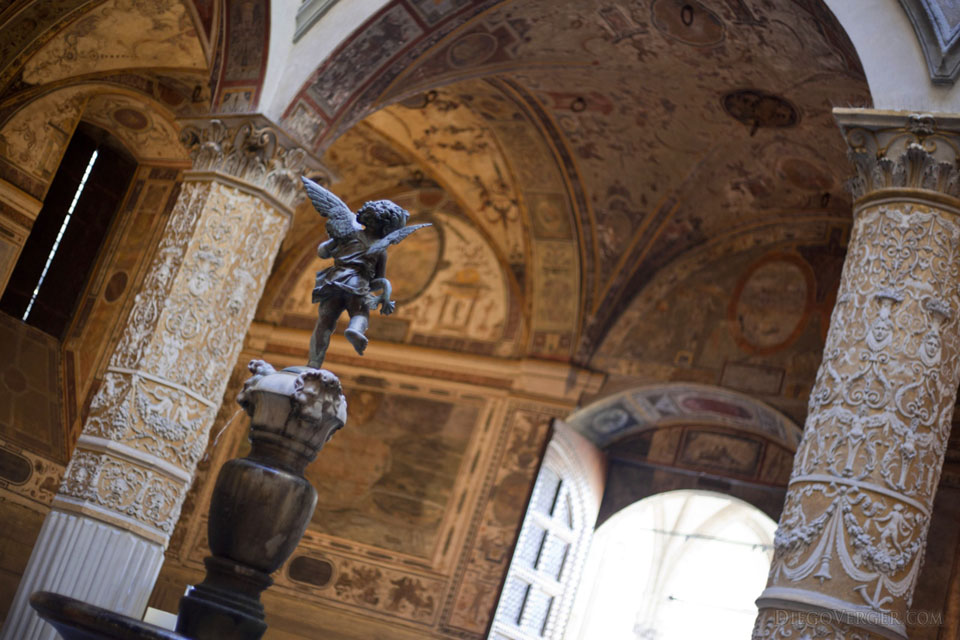
Quadripartite ribbed vault in the Palazzo Vecchio
 All the walls and ribbed vaults in the first courtyard of the "Old Palace" are decorated with frescoes, many of which are in reference to Austria, since they were painted on the occasion of the wedding between Francesco I de’ Medici and the Archduchess Joanna of Austria.
All the walls and ribbed vaults in the first courtyard of the "Old Palace" are decorated with frescoes, many of which are in reference to Austria, since they were painted on the occasion of the wedding between Francesco I de’ Medici and the Archduchess Joanna of Austria.
Giotto's Bell Tower next to the Florence Cathedral
 In this photo you can appreciate the artistical and architectural consistency across the campanile and the cathedral. The white, red and green inlaid marble, as well as the geometric shapes, stylistically unite the campanile with the adjacent cathedral.
In this photo you can appreciate the artistical and architectural consistency across the campanile and the cathedral. The white, red and green inlaid marble, as well as the geometric shapes, stylistically unite the campanile with the adjacent cathedral.
Florence Cathedral façade
A closer view of the façade where you can see the rose window better, as well as the statues of 6 out of the 12 apostles, and those of Mary and Jesus. This layout is similar to the one in Notre-Dame de Paris, in that the façade is decorated with a series of statues below the rose window, like the gallery of the kings of Judah in Notre-Dame.
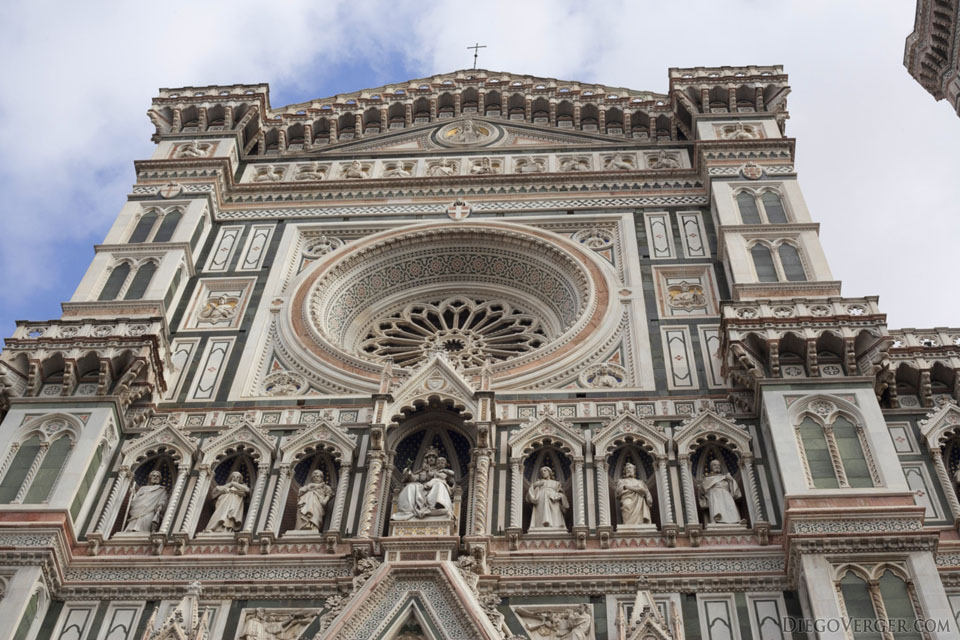
Hercules and Centaur Nessus sculpture
 Another of the sculptures in the "Loggia della Signoria" (or "Loggia dei Lanzi"), a work by the Flemish sculptor Jean Boulogne, also known as Giambologna.
Another of the sculptures in the "Loggia della Signoria" (or "Loggia dei Lanzi"), a work by the Flemish sculptor Jean Boulogne, also known as Giambologna.
Side door of the Cathedral Santa Maria del Fiore
 North door of the cathedral’s nave, demarcated by two columns supported by lions. The wooden door features low-reliefs portraying a lamb with a cross, the symbol of "OPA," an organization within the medieval Florentine Guild of Wool, responsible for supervising and protecting the works ("Opere") of the cathedral; this symbol can also be seen throughout the works of the Miracle Square ("Piazza dei Miracoli") in Pisa.
North door of the cathedral’s nave, demarcated by two columns supported by lions. The wooden door features low-reliefs portraying a lamb with a cross, the symbol of "OPA," an organization within the medieval Florentine Guild of Wool, responsible for supervising and protecting the works ("Opere") of the cathedral; this symbol can also be seen throughout the works of the Miracle Square ("Piazza dei Miracoli") in Pisa.
Brunelleschi's dome of the Florence Cathedral
Statue of David in Michelangelo square
 Bronze replica of the David by Michelangelo in piazzale Michelangelo, south of the Arno.
Bronze replica of the David by Michelangelo in piazzale Michelangelo, south of the Arno.
Fountain of Neptune in Piazza della Signoria
A giant Neptune on a carriage holding what appears to be a scroll, surrounded by humans below and anthropomorphic aquatic creatures made of a contrasting bronze material. This is a work by Bartolomeo Ammannati of the 16th century, and is located next to the Old Palace ("Palazzo Vecchio").

Patroclus and Menelaus in the Loggia della Signoria
 Menelaus holding Patroclus’ body, a scene from the Trojan War. It has also been postulated that this sculpture of Hellenistic style might represent Ajax supporting Achilles.
Menelaus holding Patroclus’ body, a scene from the Trojan War. It has also been postulated that this sculpture of Hellenistic style might represent Ajax supporting Achilles.
Uffizi Gallery
 The "Uffizi" or Offices Gallery was built in the late sixteenth century as administrative offices for the city of Florence, it became a receptacle for many works of art belonging to the Medici, and by the eighteenth century it became a public museum. In the center you can also see part of the Vasarian Corridor which goes through the museum.
The "Uffizi" or Offices Gallery was built in the late sixteenth century as administrative offices for the city of Florence, it became a receptacle for many works of art belonging to the Medici, and by the eighteenth century it became a public museum. In the center you can also see part of the Vasarian Corridor which goes through the museum.
Detail of the right side of the Florence Cathedral front façade
 In this night picture you can see the right portal by Giuseppe Cassioli, one of the side rose windows, and Giotto’s Campanile or Bell Tower.
In this night picture you can see the right portal by Giuseppe Cassioli, one of the side rose windows, and Giotto’s Campanile or Bell Tower.
Detail of the Palazzo Vecchio façade
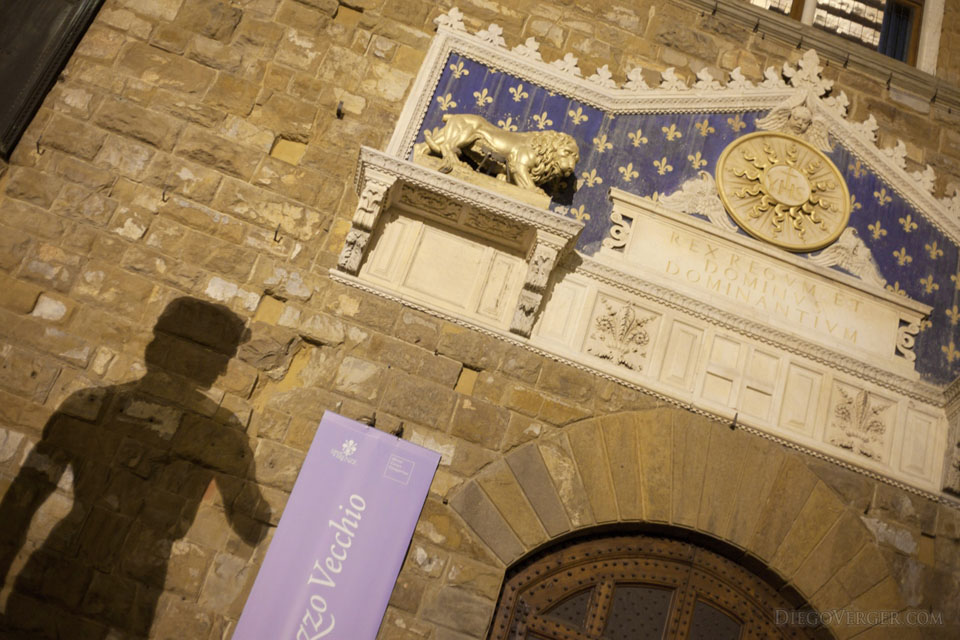 In this photo you can see the ornamental marble above the main entrance to the Palazzo Vecchio, or "Palazzo Della Signoria", with the fleur-de-lis (the emblem of Florence), one of the two lions, the solar disc with the Christogram YHS (monogram of Jesus) and the inscription "REX REGUM ET DOMINUS DOMINANTIUM" (King of kings and Lord of lords).
In this photo you can see the ornamental marble above the main entrance to the Palazzo Vecchio, or "Palazzo Della Signoria", with the fleur-de-lis (the emblem of Florence), one of the two lions, the solar disc with the Christogram YHS (monogram of Jesus) and the inscription "REX REGUM ET DOMINUS DOMINANTIUM" (King of kings and Lord of lords).
This marble frontispiece in the Palazzo Vecchio is a vestige from turbulent Renaissance times in the Republic of Florence, and its inscriptions were used to communicate decisions about the city’s sovereignty. In 1527, the Medici were arduously disputing with other factions to preserve the power they had regained in 1512, and maintained during the papacy of Leo X (Giovanni di Lorenzo de’ Medici). But this power struggle was not limited to Florence; in the same year, 1527, in Rome, the pope Clement VII (Giulio de’ Medici) took shelter in the Sant’Angelo Castle, after Carlos I of Spain besieged Rome and vanquished the papal Swiss military guard. In the meantime, the Council of the Republic of Florence was deciding the sovereignty of Florence, and the Christogram and inscription were placed as the frontispiece of the Palazzo Vecchio after one of their voting sessions, in order to declare Christ as their king and therefore symbolically eliminate the authority of the Medici, affirming the sovereignty of the Republic, and pacifying the populace. Although such decisions would not last for long, since after some agreements in 1532, the pope Clement VII was back in power and placed Alessandro de’ Medici in charge of the city as Duke of Florence, and the Republic is dissolved.
According to Modesto Rastrelli in his book "Illustrazione Istorica Del Palazzo Della Signoria detto inoggi il Palazzo Vecchio" [*] of 1792, the original inscription was "YHS, XPS, REX" in golden letters, then spelled in Latin as "Jesus Christus Rex Florentini" (Jesus Christ, King of Florence). XPS is a variant of the Christogram using Greek letters (???st?? = Christus = Christ). But it would be modified in the 19th century; nowadays only the first Christogram can be seen, YHS, with the solar rays, characteristic symbols of the Society of Jesus, or Jesuit order, together with the inscription mentioned previously, which can be seen in the photo.
[*] "Historical Illustration of the Palazzo della Signoria, now known as Palazzo Vecchio"
Giotto's Bell tower
 An extreme view of the imposing bell tower by Giotto di Bondone in piazza del Duomo.
An extreme view of the imposing bell tower by Giotto di Bondone in piazza del Duomo.
Panoramic view of Florence
A photo of the historic center of Florence from Michelangelo square ("Piazzale Michelangelo"), to the south of the Arno, which features, from left to right, the Old Bridge ("Ponte Vecchio"), the Old Palace ("Palazzo Vecchio"), Giotto’s Bell Tower, the Duomo or Cathedral Santa Maria del Fiore, the National Central Library of Florence (the building with two towers overlooking the river), and the Basilica of the Holy Cross ("Basilica di Santa Croce").

Media (40)
 Dome of the Cathedral of Florence
Dome of the Cathedral of Florence
 The city of Florence
The city of Florence
 Façade of the Cathedral of Santa Maria del Fiore
Façade of the Cathedral of Santa Maria del Fiore
 Detail of the façade of the Florence Cathedral
Detail of the façade of the Florence Cathedral
 Giotto’s Bell tower and Florence Cathedral façade by day
Giotto’s Bell tower and Florence Cathedral façade by day
 Giotto’s Campanile and Florence Cathedral façade by night
Giotto’s Campanile and Florence Cathedral façade by night
 The Abduction of Polyxena
The Abduction of Polyxena
 Santa Maria del Fiore from the streets of Florence
Santa Maria del Fiore from the streets of Florence
 Ponte Vecchio by day
Ponte Vecchio by day
 Ponte Vecchio by night
Jewelry stores in Ponte Vecchio - Florence ⚜
Jewelry stores in Ponte Vecchio
Palazzo Vecchio by night - Florence ⚜
Palazzo Vecchio by night
Bicycle of a store in the streets of Florence - Florence ⚜
Bicycle of a store in the streets of Florence
Palazzo Vecchio tower by day - Florence ⚜
Palazzo Vecchio tower by day
Detail of the façade of Palazzo Vecchio - Florence ⚜
Detail of the façade of Palazzo Vecchio
Detail of the apse of the Florence Cathedral - Florence ⚜
Detail of the apse of the Florence Cathedral
Little angel with Dolphin in the Palazzo Vecchio - Florence ⚜
Little angel with Dolphin in the Palazzo Vecchio
Quadripartite ribbed vault in the Palazzo Vecchio - Florence ⚜
Quadripartite ribbed vault in the Palazzo Vecchio
Giotto’s Bell Tower next to the Florence Cathedral - Florence ⚜
Giotto’s Bell Tower next to the Florence Cathedral
Florence Cathedral façade - Florence ⚜
Florence Cathedral façade
Giotto’s Campanile - Florence ⚜
Giotto’s Campanile
Gothic vaults of Palazzo Vecchio - Florence ⚜
Gothic vaults of Palazzo Vecchio
Hercules and Centaur Nessus sculpture - Florence ⚜
Hercules and Centaur Nessus sculpture
Side door of the Cathedral Santa Maria del Fiore - Florence ⚜
Side door of the Cathedral Santa Maria del Fiore
Apsidiole of the Florence Cathedral - Florence ⚜
Apsidiole of the Florence Cathedral
Brunelleschi’s dome and apsidiole in Santa Maria del Fiore - Florence ⚜
Brunelleschi’s dome and apsidiole in Santa Maria del Fiore
Brunelleschi’s dome of the Florence Cathedral - Florence ⚜
Brunelleschi’s dome of the Florence Cathedral
Interior of the first courtyard in Palazzo Vecchio - Florence ⚜
Interior of the first courtyard in Palazzo Vecchio
Statue of David in Michelangelo square - Florence ⚜
Statue of David in Michelangelo square
Fountain of Neptune in Piazza della Signoria - Florence ⚜
Fountain of Neptune in Piazza della Signoria
Pond in the Giardino della Fortezza - Florence ⚜
Pond in the Giardino della Fortezza
Fortezza da Basso - Florence ⚜
Fortezza da Basso
Patroclus and Menelaus in the Loggia della Signoria - Florence ⚜
Patroclus and Menelaus in the Loggia della Signoria
Uffizi Gallery - Florence ⚜
Uffizi Gallery
Brunelleschi’s dome, lantern and north façade of the cathedral - Florence ⚜
Brunelleschi’s dome, lantern and north façade of the cathedral
The Abduction of Polyxena of 1865 - Florence ⚜
The Abduction of Polyxena of 1865
Detail of the right side of the Florence Cathedral front façade - Florence ⚜
Detail of the right side of the Florence Cathedral front façade
Detail of the Palazzo Vecchio façade - Florence ⚜
Detail of the Palazzo Vecchio façade
Giotto’s Bell tower - Florence ⚜
Giotto’s Bell tower
Panoramic view of Florence - Florence ⚜
Panoramic view of Florence
Ponte Vecchio by night
Jewelry stores in Ponte Vecchio - Florence ⚜
Jewelry stores in Ponte Vecchio
Palazzo Vecchio by night - Florence ⚜
Palazzo Vecchio by night
Bicycle of a store in the streets of Florence - Florence ⚜
Bicycle of a store in the streets of Florence
Palazzo Vecchio tower by day - Florence ⚜
Palazzo Vecchio tower by day
Detail of the façade of Palazzo Vecchio - Florence ⚜
Detail of the façade of Palazzo Vecchio
Detail of the apse of the Florence Cathedral - Florence ⚜
Detail of the apse of the Florence Cathedral
Little angel with Dolphin in the Palazzo Vecchio - Florence ⚜
Little angel with Dolphin in the Palazzo Vecchio
Quadripartite ribbed vault in the Palazzo Vecchio - Florence ⚜
Quadripartite ribbed vault in the Palazzo Vecchio
Giotto’s Bell Tower next to the Florence Cathedral - Florence ⚜
Giotto’s Bell Tower next to the Florence Cathedral
Florence Cathedral façade - Florence ⚜
Florence Cathedral façade
Giotto’s Campanile - Florence ⚜
Giotto’s Campanile
Gothic vaults of Palazzo Vecchio - Florence ⚜
Gothic vaults of Palazzo Vecchio
Hercules and Centaur Nessus sculpture - Florence ⚜
Hercules and Centaur Nessus sculpture
Side door of the Cathedral Santa Maria del Fiore - Florence ⚜
Side door of the Cathedral Santa Maria del Fiore
Apsidiole of the Florence Cathedral - Florence ⚜
Apsidiole of the Florence Cathedral
Brunelleschi’s dome and apsidiole in Santa Maria del Fiore - Florence ⚜
Brunelleschi’s dome and apsidiole in Santa Maria del Fiore
Brunelleschi’s dome of the Florence Cathedral - Florence ⚜
Brunelleschi’s dome of the Florence Cathedral
Interior of the first courtyard in Palazzo Vecchio - Florence ⚜
Interior of the first courtyard in Palazzo Vecchio
Statue of David in Michelangelo square - Florence ⚜
Statue of David in Michelangelo square
Fountain of Neptune in Piazza della Signoria - Florence ⚜
Fountain of Neptune in Piazza della Signoria
Pond in the Giardino della Fortezza - Florence ⚜
Pond in the Giardino della Fortezza
Fortezza da Basso - Florence ⚜
Fortezza da Basso
Patroclus and Menelaus in the Loggia della Signoria - Florence ⚜
Patroclus and Menelaus in the Loggia della Signoria
Uffizi Gallery - Florence ⚜
Uffizi Gallery
Brunelleschi’s dome, lantern and north façade of the cathedral - Florence ⚜
Brunelleschi’s dome, lantern and north façade of the cathedral
The Abduction of Polyxena of 1865 - Florence ⚜
The Abduction of Polyxena of 1865
Detail of the right side of the Florence Cathedral front façade - Florence ⚜
Detail of the right side of the Florence Cathedral front façade
Detail of the Palazzo Vecchio façade - Florence ⚜
Detail of the Palazzo Vecchio façade
Giotto’s Bell tower - Florence ⚜
Giotto’s Bell tower
Panoramic view of Florence - Florence ⚜
Panoramic view of Florence






